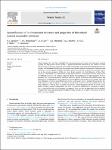Quantification of 3-dimensional structure and properties of flocculated natural suspended sediment
| dc.contributor.author | Spencer, KL | |
| dc.contributor.author | Wheatland, JA | |
| dc.contributor.author | Carr, SJ | |
| dc.contributor.author | Manning, Andrew | |
| dc.contributor.author | Bushby, AJ | |
| dc.contributor.author | Gu, C | |
| dc.contributor.author | Botto, L | |
| dc.contributor.author | Lawrence, T | |
| dc.date.accessioned | 2023-05-04T23:32:26Z | |
| dc.date.available | 2023-05-04T23:32:26Z | |
| dc.date.issued | 2022-08 | |
| dc.identifier.issn | 0043-1354 | |
| dc.identifier.issn | 1879-2448 | |
| dc.identifier.other | 118835 | |
| dc.identifier.uri | https://pearl.plymouth.ac.uk/handle/10026.1/20803 | |
| dc.description.abstract |
Natural sediment flocs are fragile and highly heterogeneous aggregates of biogenic and minerogenic material typically with high porosity and low density. In aquatic environments dominated by fine, cohesive or mixed sediments they can dominate suspended sediment flux. Consequently, monitoring and modelling the behaviour, transport and distribution of flocs is very important for many aquatic industries, maintenance of waterways and conservation and management of aquatic waterbodies. Mathematical models that predict the behaviour of flocs rely on the accurate assessments of the size, shape, density, porosity and fractal dimension of flocs. These inherently 3-dimensional (3D) characteristics are typically derived from 2-dimensional (2D) data, largely due to the challenges associated with sampling, capturing, imaging and quantifying these fragile aggregates. We have developed new volumetric microscopy techniques which can quantify 3D internal and external structures and characteristics of sediment flocs. Here, these techniques were applied to quantify the 3D size (volume), shape and fractal dimension of natural and artificial sediment flocs and compare them to standard 2D approaches. Our study demonstrates that 2D approaches are under-estimating shape complexity and over-estimating the size and mass settling flux of flocs by up to two orders of magnitude, and the discrepancy between 2D and 3D is most marked for natural, organic rich macroflocs. Our study has significant implications for estimations of sediment flux at local to global scales within in aquatic environments. These new data and approaches offer the potential to improve the current parameterisation of sediment transport models and to improve the accuracy of current field-monitoring techniques. | |
| dc.format.extent | 118835-118835 | |
| dc.format.medium | Print-Electronic | |
| dc.language | en | |
| dc.publisher | Elsevier BV | |
| dc.subject | Cohesive | |
| dc.subject | Density | |
| dc.subject | Porosity, fractal dimension | |
| dc.subject | Shape | |
| dc.subject | Flocculation | |
| dc.subject | Fractals | |
| dc.subject | Geologic Sediments | |
| dc.subject | Models, Theoretical | |
| dc.subject | Porosity | |
| dc.title | Quantification of 3-dimensional structure and properties of flocculated natural suspended sediment | |
| dc.type | journal-article | |
| dc.type | Journal Article | |
| plymouth.author-url | https://www.ncbi.nlm.nih.gov/pubmed/35914497 | |
| plymouth.volume | 222 | |
| plymouth.publication-status | Published | |
| plymouth.journal | Water Research | |
| dc.identifier.doi | 10.1016/j.watres.2022.118835 | |
| plymouth.organisational-group | |Plymouth | |
| plymouth.organisational-group | |Plymouth|Research Groups | |
| plymouth.organisational-group | |Plymouth|Faculty of Science and Engineering | |
| plymouth.organisational-group | |Plymouth|Faculty of Science and Engineering|School of Biological and Marine Sciences | |
| plymouth.organisational-group | |Plymouth|Research Groups|Marine Institute | |
| plymouth.organisational-group | |Plymouth|REF 2021 Researchers by UoA | |
| plymouth.organisational-group | |Plymouth|Users by role | |
| plymouth.organisational-group | |Plymouth|Users by role|Academics | |
| plymouth.organisational-group | |Plymouth|REF 2021 Researchers by UoA|UoA07 Earth Systems and Environmental Sciences | |
| dc.publisher.place | England | |
| dcterms.dateAccepted | 2022-07-06 | |
| dc.date.updated | 2023-05-04T23:32:11Z | |
| dc.rights.embargodate | 2023-8-16 | |
| dc.identifier.eissn | 1879-2448 | |
| dc.rights.embargoperiod | forever | |
| rioxxterms.versionofrecord | 10.1016/j.watres.2022.118835 |


